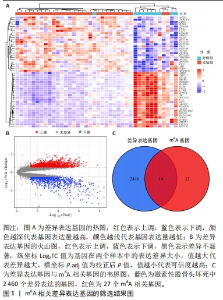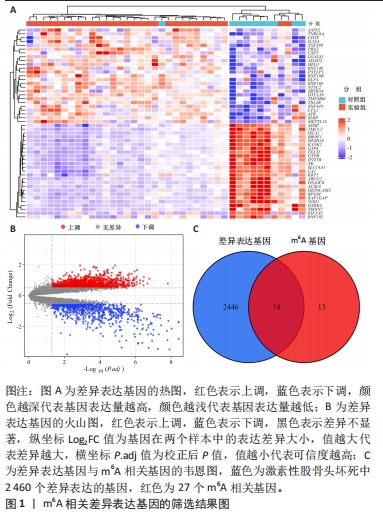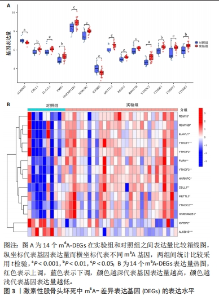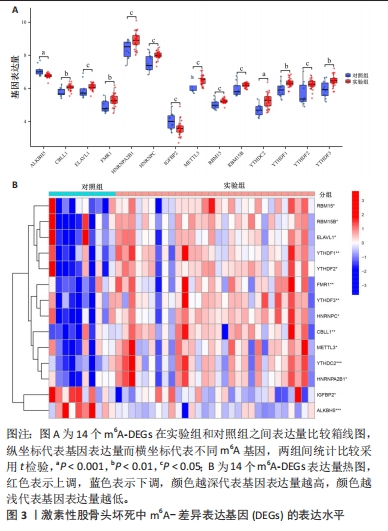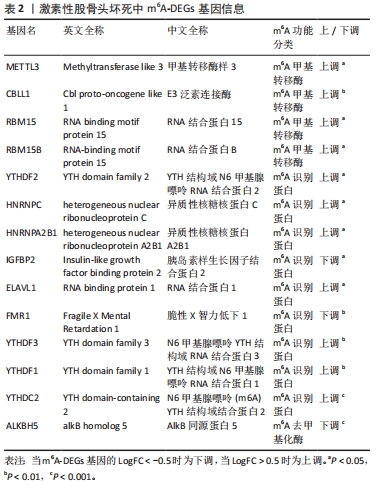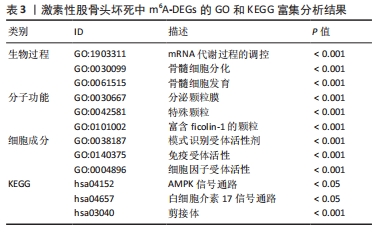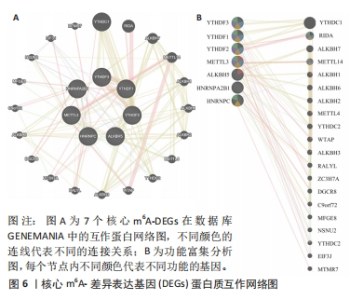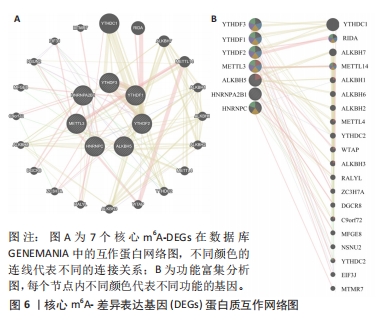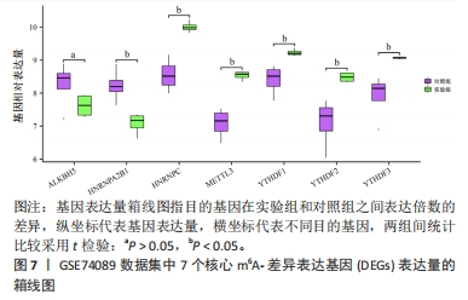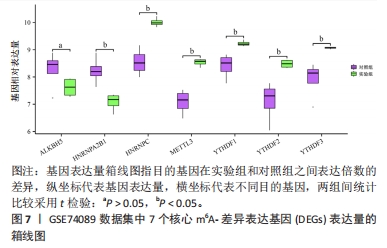Chinese Journal of Tissue Engineering Research ›› 2024, Vol. 28 ›› Issue (36): 5811-5816.doi: 10.12307/2024.698
Previous Articles Next Articles
Bioinformatics analysis of m6A-associated genes in steroid-induced osteonecrosis of the femoral head
Linghu Xitao1, Gui Jiaqi2, Liang Zhuozhi2, Wa Qingde1, Huang Shuai2
- 1Department of Orthopedics, Second Affiliated Hospital of Zunyi Medical University, Zunyi 563000, Guizhou Province, China; 2Department of Orthopedics, Second Affiliated Hospital of Guangzhou Medical University, Guangzhou 510260, Guangdong Province, China
-
Received:2023-10-23Accepted:2023-12-04Online:2024-12-28Published:2024-02-27 -
Contact:Huang Shuai, PhD, Associate chief physician, Associate professor, Doctoral supervisor, Department of Orthopedics, Second Affiliated Hospital of Guangzhou Medical University, Guangzhou 510260, Guangdong Province, China -
About author:Linghu Xitao, Master, Physician, Department of Orthopedics, Second Affiliated Hospital of Zunyi Medical University, Zunyi 563000, Guizhou Province, China -
Supported by:Guangzhou Science and Technology Planning Project, No. 2023A03J0405 (to HS); a Project of Guizhou Science and Technology Plan, No. Qian Kehe Foundation-ZK[2021] 007 (to WQD)
CLC Number:
Cite this article
Linghu Xitao, Gui Jiaqi, Liang Zhuozhi, Wa Qingde, Huang Shuai. Bioinformatics analysis of m6A-associated genes in steroid-induced osteonecrosis of the femoral head[J]. Chinese Journal of Tissue Engineering Research, 2024, 28(36): 5811-5816.
share this article
Add to citation manager EndNote|Reference Manager|ProCite|BibTeX|RefWorks
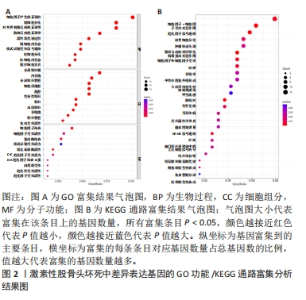
2.2 DEGs的GO功能富集及KEGG通路富集分析结果 对差异表达基因的GO和KEGG富集分析结果进行筛选,富集结果中BP,CC,MF及KEGG通路分别有307,44,18,15条。其中BP主要富集在细胞因子产生的正向调节、骨髓细胞分化、髓细胞发育、活性氧代谢过程、骨髓细胞稳态等条目,CC主要富集在分泌颗粒膜、特定颗粒、富含ficolin-1的颗粒、内吞囊泡、细胞质囊泡腔、富含ficolin-1的颗粒管腔等条目,MF主要富集在免疫受体活性、细胞因子受体活性、C-C趋化因子受体活性、氧化还原酶活性、趋化因子受体及趋化因子结合等条目,见图2A,B。KEGG通路富集结果显示,DEGs主要与破骨细胞分化(P < 0.001)、趋化因子信号通路(P < 0.001)及核转录因子κB信号通路(P < 0.05)等有关。"
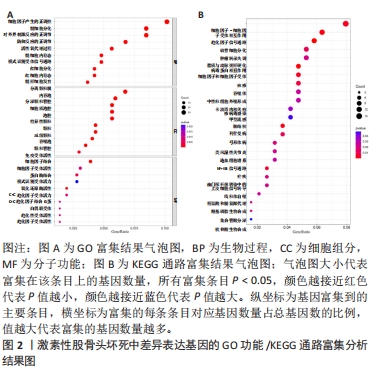

2.4 m6A-DEGs基因相关性及GO/KEGG通路富集分析结果 对上述14个激素性股骨头坏死中表达差异的m6A-DEGs进行了Spearman相关性分析,结果显示14个m6A-DEGs存在一定的相关性,其中正相关性最高的是YTHDC2与HNRNPA2B1 (Cor=0.929),负相关性最高的是HNRNPC与ALKBH5(Cor=-0.672),见图4A。此外,对14个m6A-DEGs基因进行了GO/KEGG通路富集分析,共富集到生物学过程245个条目、 细胞组分17个条目、 分子功能41个条目和KEGG 通路10个条目。GO分析结果中BP主要包括了mRNA代谢过程的调控、mRNA稳定性调控、RNA稳定性调节、骨髓细胞分化、骨髓细胞发育,CC主要包括了分泌颗粒膜、特殊颗粒、富含ficolin-1的颗粒,MF主要包括了模式识别受体活性剂、免疫受体活性、细胞因子受体活性,KEGG包括了IL-17信号通路、AMPK信号通路等,结果见图4B,C及表3。"
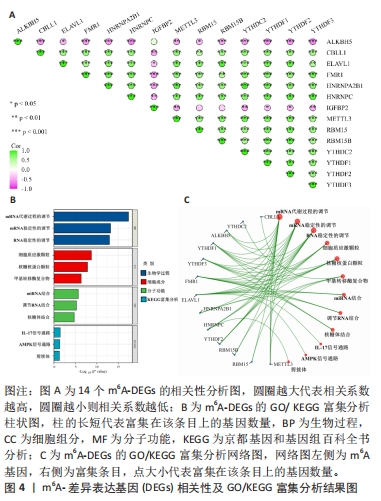

2.5 m6A-DEGs基因PPI网络及TF-m6A-miRNA预测分析结果 将14个m6A-DEGs基因导入在线工具STRING中,根据score分数> 0.04进行筛选,将在线结果导入Cytoscape软件中绘制PPI 网络图,该网络图包括14个节点和85条交互关系,见图5A。使用Degree算法筛选出连接关系前7个基因作为核心基因:YTHDF1,YTHDF2,YTHDF3,ALKBH5,HNRNPA2B1,HNRNPC及METTL3(Degree度值均为13),见图5B。利用miRTarBase,miRDB,TargetScan数据库预测7个核心基因潜在的miRNA并作交集分析,在3个数据库中共筛选出44个miRNA,交集基因可视化结果见图5C。利用ChIPBase及hTFtarget数据库预测7个核心基因潜在转录因子并作交集分析,共筛选出79个TF,交集结果可视化结果见图5D。"
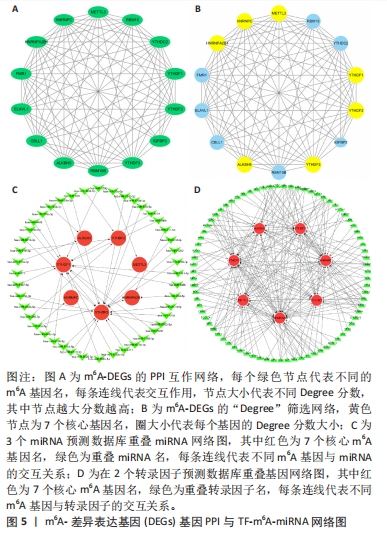
| [1] FUKUSHIMA W, FUJIOKA M, KUBO T, et al. Nationwide epidemiologic survey of idiopathic osteonecrosis of the femoral head. Clin Orthop Relat Res. 2010;468(10): 2715-2724. [2] GUERADO E, CASO E. The physiopathology of avascular necrosis of the femoral head: an update. Injury. 2016;47 Suppl 6:S16-S26. [3] YUE J, YU H, LIU P, et al. Preliminary study of icariin indicating prevention of steroid-induced osteonecrosis of femoral head by regulating abnormal expression of miRNA-335 and protecting the functions of bone microvascular endothelial cells in rats. Gene. 2021;766:145128. [4] HUANG C, WEN Z, NIU J, et al. Steroid-induced osteonecrosis of the femoral head: novel insight into the roles of bone endothelial cells in pathogenesis and treatment. Front Cell Dev Biol. 2021;9:777697. [5] GUAN Q, LIN H, MIAO L, et al. Functions, mechanisms, and therapeutic implications of METTL14 in human cancer. J Hematol Oncol. 2022;15(1):13. [6] 陈伟坚,张罡瑜,林天烨,等.RNA m6A甲基化修饰参与及调控骨科相关疾病[J].中国组织工程研究,2021,25(26):4236-4242. [7] XU Y, YE S, ZHANG N, et al. The FTO/miR-181b-3p/ARL5B signaling pathway regulates cell migration and invasion in breast cancer. Cancer Commun (Lond). 2020;40(10):484-500. [8] CHENG C, ZHANG H, ZHENG J, et al. METTL14 benefits the mesenchymal stem cells in patients with steroid-associated osteonecrosis of the femoral head by regulating the m6A level of PTPN6. Aging (Albany NY). 2021;13(24):25903-25919. [9] WANG Y, ZHANG Y, LU H, et al. Integrative analysis of cellular autophagy-related genes in steroid-induced osteonecrosis of the femoral head. Am J Transl Res. 2023; 15(9):5850-5872. [10] CHAI JL, LU BW, DU HT, et al. Pyroptosis-related potential diagnostic biomarkers in steroid-induced osteonecrosis of the femoral head. BMC Musculoskelet Disord. 2023;24(1):609. [11] LU H, FAN Y, YAN Q, et al. Identification and validation of ferroptosis-related biomarkers in steroid-induced osteonecrosis of the femoral head. Int Immunopharmacol. 2023;124(Pt A):110906. [12] ZHOU R, PARK JW, CHUN RF, et al. Concerted effects of heterogeneous nuclear ribonucleoprotein C1/C2 to control vitamin D-directed gene transcription and RNA splicing in human bone cells. Nucleic Acids Res. 2017;45(2):606-618. [13] WEN JR, TAN Z, LIN WM, et al. Role of m (6)A Reader YTHDC2 in differentiation of human bone marrow mesenchymal stem cells. Sichuan Da Xue Xue Bao Yi Xue Ban. 2021;52(3):402-408. [14] BAI J, ZHANG W, ZHOU C, et al. MFG-E8 promotes osteogenic differentiation of human bone marrow mesenchymal stem cells through GSK3beta/beta-catenin signaling pathway. FASEB J. 2023;37(6):e22950. [15] CHOI YJ, JEONG S, YOON KA, et al. Deficiency of DGCR8 increases bone formation through downregulation of miR-22 expression. Bone. 2017;103:287-294. [16] 恽波,周灵杰,凡进,等.GIT1通过Notch信号通路促进骨髓细胞向破骨细胞分化[J]. 南京医科大学学报(自然科学版),2016,36(9):1036-1040. [17] JIANG Y, ZHANG Y, CHEN W, et al. Correction to: achyranthes bidentata extract exerts osteoprotective effects on steroid-induced osteonecrosis of the femoral head in rats by regulating RANKL/RANK/OPG signaling. J Transl Med. 2021;19(1):208. [18] LIU Y, SHAN H, ZONG Y, et al. IKKe in osteoclast inhibits the progression of methylprednisolone-induced osteonecrosis. Int J Biol Sci. 2021;17(5):1353-1360. [19] WANG N, WANG L, YANG J, et al. Quercetin promotes osteogenic differentiation and antioxidant responses of mouse bone mesenchymal stem cells through activation of the AMPK/SIRT1 signaling pathway. Phytother Res. 2021. doi:10.1002/ptr.7010.LA. [20] JIANG T, XIA C, CHEN X, et al. Melatonin promotes the BMP9-induced osteogenic differentiation of mesenchymal stem cells by activating the AMPK/beta-catenin signalling pathway. Stem Cell Res Ther. 2019;10(1):408. [21] KIM HJ, SEO SJ, KIM JY, et al. IL-17 promotes osteoblast differentiation, bone regeneration, and remodeling in mice. Biochem Biophys Res Commun. 2020;524(4): 1044-1050. [22] SUN J, DENG Y, SHI J, et al. MicroRNA‑542‑3p represses OTUB1 expression to inhibit migration and invasion of esophageal cancer cells. Mol Med Rep. 2020;21(1):35-42. [23] ZHANG HM, KUANG S, XIONG X, et al. Transcription factor and microRNA co-regulatory loops: important regulatory motifs in biological processes and diseases. Brief Bioinform. 2015;16(1):45-58. [24] TONG W, WENZE G, LIBING H, et al. Exploration of shared TF-miRNA‒mRNA and mRNA-RBP-pseudogene networks in type 2 diabetes mellitus and breast cancer. Front Immunol. 2022;13:915017. [25] XIAO Z, ZHOU M, JI X, et al. Research progress of microRNA-21 in femoral head necrosis: a review. Asian J Surg. 2023;46(7):3003-3004. [26] CUI Y, HUANG T, ZHANG Z, et al. The potential effect of BMSCs with miR-27a in improving steroid-induced osteonecrosis of the femoral head. Sci Rep. 2022;12(1):21051. [27] ZHUANG Y, CHENG M, LI M, et al. Small extracellular vesicles derived from hypoxic mesenchymal stem cells promote vascularized bone regeneration through the miR-210-3p/EFNA3/PI3K pathway. Acta Biomater. 2022;150:413-426. [28] CHEN Y, YU H, ZHU D, et al. miR-136-3p targets PTEN to regulate vascularization and bone formation and ameliorates alcohol-induced osteopenia. FASEB J. 2020; 34(4):5348-5362. [29] NAN K, ZHANG Y, ZHANG X, et al. Exosomes from miRNA-378-modified adipose-derived stem cells prevent glucocorticoid-induced osteonecrosis of the femoral head by enhancing angiogenesis and osteogenesis via targeting miR-378 negatively regulated suppressor of fused (Sufu). Stem Cell Res Ther. 2021;12(1):331. [30] LI G, LIU H, ZHANG X, et al. The protective effects of microRNA-26a in steroid-induced osteonecrosis of the femoral head by repressing EZH2. Cell Cycle. 2020; 19(5):551-566. [31] CHEN Y, TANG B, JIANG W, et al. miR-486-5p attenuates steroid-induced adipogenesis and osteonecrosis of the femoral head via TBX2/P21 axis. Stem Cells. 2023;41(7):711-723. [32] KONG L, ZUO R, WANG M, et al. Silencing microRNA-137-3p, which Targets RUNX2 and CXCL12 prevents steroid-induced osteonecrosis of the femoral head by facilitating osteogenesis and angiogenesis. Int J Biol Sci. 2020;16(4):655-670. [33] LIMLAWAN P, MARGER L, DURUAL S, et al. Delivery of microRNA-302a-3p by APTES modified hydroxyapatite nanoparticles to promote osteogenic differentiation in vitro. BDJ Open. 2023;9(1):8. [34] YUAN X, SHI L, GUO Y, et al. METTL3 regulates ossification of the posterior longitudinal ligament via the lncRNA XIST/miR-302a-3p/USP8 axis. Front Cell Dev Biol. 2021;9:629895. [35] 杨礼庆,董成建,朱姝.成骨分化与修复调控转录因子Runx2在股骨头坏死组织中的表达:非随机平行对照临床观察试验方案[J].中国组织工程研究, 2016,20(17):24529-24534. [36] LIU DD, ZHANG CY, LIU Y, et al. RUNX2 regulates osteoblast differentiation via the BMP4 signaling pathway. J Dent Res. 2022;101(10):1227-1237. [37] WANG FS, CHEN YS, KO JY, et al. Bromodomain protein BRD4 accelerates glucocorticoid dysregulation of bone mass and marrow adiposis by modulating H3K9 and Foxp1. Cells. 2020;9(6):1500. [38] TAI P, WUH, VAN WIJNEN AJ, et al. Genome-wide DNase hypersensitivity, and occupancy of RUNX2 and CTCF reveal a highly dynamic gene regulome during MC3T3 pre-osteoblast differentiation. PLoS One. 2017;12(11):e188056. [39] YU S, GUO J, SUN Z, et al. BMP2-dependent gene regulatory network analysis reveals Klf4 as a novel transcription factor of osteoblast differentiation. Cell Death Dis. 2021;12(2):197. |
| [1] | Sheng Siqi, Xie Lin, Zhao Xiangyu, Jiang Yideng, Wu Kai, Xiong Jiantuan, Yang Anning, Hao Yinju, Jiao Yun. Involvement of miR-144-3p in Cbs+/- mouse hepatocyte autophagy induced by high-methionine diet [J]. Chinese Journal of Tissue Engineering Research, 2024, 28(8): 1289-1294. |
| [2] | Bu Xianzhong, Bu Baoxian, Xu Wei, Zhang Chi, Zhang Yisheng, Zhong Yuanming, Li Zhifei, Tang Fubo, Mai Wei, Zhou Jinyan. Analysis of serum differential proteomics in patients with acute cervical spondylotic radiculopathy [J]. Chinese Journal of Tissue Engineering Research, 2024, 28(4): 535-541. |
| [3] | Lan Yao, Chen Liuyang, Song Wenhui. Key biomarkers for the diagnosis of intervertebral disc degeneration associated with oxidative stress: identification based on bioinformatics and machine learning [J]. Chinese Journal of Tissue Engineering Research, 2024, 28(35): 5591-5597. |
| [4] | Tang Lulu, Pan Xiaojia, Lai Yingtao, Wang Li. Regulatory mechanism of ferroptosis on pressure ulcers: bioinformatics analysis and experimental validation [J]. Chinese Journal of Tissue Engineering Research, 2024, 28(35): 5656-5661. |
| [5] | Lu Xiaoling, Liu Bin, Xu Bin. Bioinformatics identification and validation of genes related to fatty acid metabolism in rheumatoid arthritis [J]. Chinese Journal of Tissue Engineering Research, 2024, 28(32): 5116-5121. |
| [6] | Chen Guanting, Zhang Linqi, Wang Xixi, Chen Xu. Autophagy, ferroptosis-related targets and renal function progression in patients with chronic kidney disease: bioinformatics analysis and experimental verification [J]. Chinese Journal of Tissue Engineering Research, 2024, 28(32): 5122-5129. |
| [7] | Zhang Chike, Wang Feiqing, Wu Dan, Yang Bo, Cheng Jinyang, Chen Juan, Tang Dongxin, Liu Yang, Li Yanju. Effects of conditioned medium of acute myeloid leukemia on biology of mesenchymal stem cells [J]. Chinese Journal of Tissue Engineering Research, 2024, 28(31): 4995-5002. |
| [8] | Yuan Ping, Wang Zhihua, Wang Weizhou, Wang Wentong, He Fei. Exosome-derived microRNA with bone and joint diseases: role and mechanism [J]. Chinese Journal of Tissue Engineering Research, 2024, 28(31): 5063-5069. |
| [9] | Hu Lingli, Li Na, Li Jingyang, Zhang Eryun, Chen Yu, Gu Ying. Role of non-coding RNA and exosomes in pathogenesis of gestational diabetes mellitus and their early diagnostic value [J]. Chinese Journal of Tissue Engineering Research, 2024, 28(31): 5070-5077. |
| [10] | Xiong Yang, Zhou Shibo, Yu Xing, Bi Lianyong, Yang Jizhou, Wang Fengxian, Qu Yi, Yang Yongdong, Zhao Dingyan, Zhao He, Qiu Ziye, Jiang Guozheng. Molecular biological mechanism of acquired heterotopic ossification [J]. Chinese Journal of Tissue Engineering Research, 2024, 28(30): 4881-4888. |
| [11] | Li Shudong, Liang Xuezhen, Luo Di, Li Jiacheng, Yan Bozhao, Li Gang. Identification of biomarkers associated with ferroptosis and pyroptosis for the potential diagnosis of postmenopausal osteoporosis [J]. Chinese Journal of Tissue Engineering Research, 2024, 28(28): 4511-4515. |
| [12] | Chen Xiangshan, Liu Hua, Sun Weikang, Li Huanan. Mechanism of m6A methylation regulating bone metabolism for prevention and treatment of osteoporosis [J]. Chinese Journal of Tissue Engineering Research, 2024, 28(28): 4572-4577. |
| [13] | Yu Peng, Meng Dongfang, Li Huiying, Zhang Xiangbei. Bioinformatics identification of CA9 as a signature gene for cartilage-associated ferroptosis in steroid-induced osteonecrosis of the femoral head [J]. Chinese Journal of Tissue Engineering Research, 2024, 28(27): 4293-4299. |
| [14] | Ma Liangchen, Tian Fubao, Xu Yujuan, Tian Xinbao, Tao Ying, Chen Mengying, Lian Jiawei, Lin Ruizhu, Zhu Ning. Mechanisms underlying internal heat-type acupuncture in the treatment of steroid-induced osteonecrosis of the femoral head in rabbits [J]. Chinese Journal of Tissue Engineering Research, 2024, 28(27): 4353-4359. |
| [15] | Gong Gaojin, Huang Haixun. Oleanolic acid alleviates steroid-induced osteonecrosis of the femoral head in rats by regulating Wnt/beta-catenin signaling pathway [J]. Chinese Journal of Tissue Engineering Research, 2024, 28(27): 4373-4377. |
| Viewed | ||||||
|
Full text |
|
|||||
|
Abstract |
|
|||||
